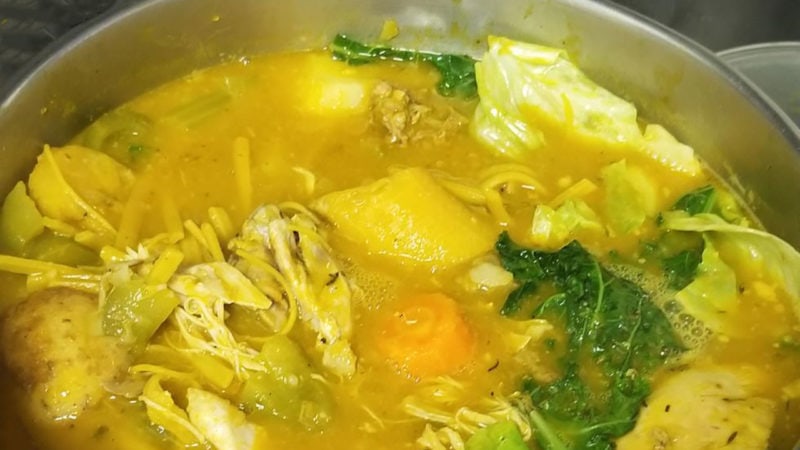Last Updated on February 2, 2022
My favorite spot in the kitchen growing up was on the countertop to the left of the stove. From there, I had direct access to whatever was being cooked. I could taste-test as frequently as my mom did, plus a few “secret” bites. In my Haitian family, food is love, joy, and celebration. It’s how we communicate with each other and how we pass on a shared history.
The History of Freedom Soup
That shared history is on full display every New Year’s Day when we celebrate Haitian Independence Day with a bowl of soup joumou. This squash soup native to Haiti represents winning freedom from the French colonizers in 1804, who forbade the Black enslaved people of Haiti to enjoy it. Visiting with friends and family, we drink it on January 1st to celebrate Haiti’s independence. And on January 2nd, we honor our ancestors who established the first free Black country in the Western Hemisphere.
Soup Making: A Family Affair
As with many Haitian dishes, this soup is a labor of love, filled with flavor and deeply satisfying. My mom prepared and marinated the meat in epis—a Haitian seasoning consisting of peppers, garlic, onions, and other spices—the night before we made the soup. The next day, she woke up early to get a head start (and I’m sure to enjoy the peace of a quiet kitchen). The children were usually tasked with peeling the garlic for epis a day or two in advance. I joke with my friends that you are officially family when you’re handed a head of garlic to peel. They knew the payoff would be worth it, so they would gladly join in.

I have countless memories of our conversations while I perched on the countertop watching and tasting as she added a bit of this, or a lot of that, to the giant soup pot. Over the years, she has started to ask, “Does this need more salt, heat, or acid?” She has demonstrated her trust in me, discreetly passing down lessons on how to pour love into my cooking.
As with any national dish, there are a ton of tweaks and variations to this recipe that people swear by. My mom doesn’t cook soup joumou with strict measurements, but from experience and with feeling. The recipe below is as close to hers as I can get.
Soup Joumou Recipe
Epis Ingredients
- 10 heads garlic
- 1 bunch scallions
- 1 bunch parsley
- 5–10 whole cloves
- Water
- Scotch bonnet pepper (optional)
Epis Instructions
Once you’ve peeled all of the garlic, put it in a blender or food processor with the parsley, scallions, cloves, and pepper. Pour enough water to cover the layer of garlic at the bottom, then blend. You’re looking for a coarse consistency. Some people add salt or bouillon cubes to their epis. I prefer adding that to the meat itself, so I have better control over the flavor profile. This makes around 32 ounces of epis, and you can use it to marinate any cut of meat or seafood.
Soup Ingredients
- 2 pounds cubed stew beef (Feel free to substitute for chicken)
- 1 pound soup bones
- 2 pounds calabaza squash, peeled and cut (You can use fresh or frozen, or kabocha squash if that’s easier for you to find.)
- A few sprigs thyme
- 4 cups water or beef broth
- 2 large potatoes, peeled and cubed
- 2 stalks celery, cut into 1-inch pieces
- 2–3 carrots, cut into 1-inch pieces
- 2–3 turnips, cut into cubes
- ½ head of cabbage
- Pasta (Some folks use noodles, rigatoni, or penne, but I like cavapatti.)
- Salt and pepper, to taste
- 2–3 limes (or sour oranges)
- Scotch bonnet pepper (optional)
- Soft bread from a Haitian bakery, to serve
Soup Instructions
Clean meat with hot water and juice of one lime, then season with epis, thyme, and salt. Marinate overnight, or for at least an hour.
In a large sauce pot, add the beef, leftover marinade (including the thyme), soup bones, and enough broth or water to cover it. Boil until tender. If you’re using fresh squash, boil it in a separate pot, then blend until smooth. Add some of the boiling squash liquid and puree to the pot. If using frozen squash, add it directly to the pot and add a bit more water. Add salt or lime juice to taste.
Add potatoes, celery, carrots, and turnips to the pot. If using a scotch bonnet pepper, cut a slice off the bottom and smell the pepper to determine how spicy it is. If you’re a fan of heat, add it at this stage. Add salt or lime juice to taste. Keep an eye on the pepper so you can manage the heat of the dish. I have bitten into whole peppers before and while I’m still here to tell the tale, it’s not a pleasant experience.
Once your starchy vegetables are nearly cooked, add your pasta and cabbage. The more pasta you add, the thicker the soup gets. Once the pasta is cooked, the soup is ready to serve!
Enjoy a bowl of soup joumou with a fresh roll or bread from a Haitian bakery.
For Black History Month, ButcherBox is celebrating Black foodways and sharing our favorite recipes from Black authors. Click Here To Learn More.



